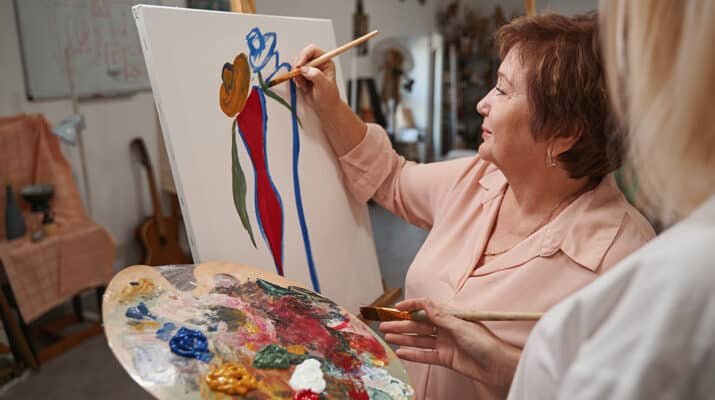By Deborah Jeanne Sergeant

You may associate art therapy with children using crayons in a therapeutic setting. But art therapy can include different media and all ages.
At Upstate Golisano Children’s Hospital, Clare Arezina, music therapist, said that music and art help with supporting memory, lifting mood and lessening pain.
“Engagement in the creative arts is an effective option,” she said. “The arts can make us feel good. Music in particular is processed in the brain in a number of areas that stimulate memory and mood: the thalamus, amygdala and the cingulate gyrus. This means that music listening can lower blood pressure, enhance relaxation response and increase feelings of wellbeing.”
The areas of the brain that are involved with making music involve the motor and language centers in the cortex. That’s why playing music and singing have been shown to improve mood and memory.
“While pain is a complex phenomenon, music and the arts can have a positive impact on many of the factors that impact pain perception — mood, muscle tension, stress response and attention,” Arezina said. “Engagement in the arts is a multisensory experience — more than one sense is involved at a time — and this can make the arts particularly helpful as an alternate engagement, which may help some patients with pain perceive their pain less.”
Patients painting a picture can smell the paint, feel the brush and see the colors before them on the canvas. The multisensory activity can be very grounding as well as distracting from pain. Taking pleasure in the process also releases “feel good” hormones that can dull pain.
“As with any treatment, effectiveness varies person to person, but there are a number of studies that demonstrate good effect of music therapy and the creative arts therapies for a variety of needs, from stroke rehabilitation to support during oncology treatments to social isolation and memory support,” Arezina said.
Art can help patients feel more connected to humanity as a whole. Every culture in the world creates art for many reasons. Identifying as a small part of a much larger group generates a sense of comfort and wholeness.
“The arts have been a way to share a collective experience throughout human history — to connect with other people, to understand their perspective and to mutually engage in a meaningful way,” Arezina said. “There are helpful uses of music and the arts that nearly any well adult can access on their own. Many people report a change in mood when attending a concert, listening to a favorite song, using a relaxation track with background music, singing in a choir, engaging in a painting workshop or using an adult coloring book, to name just a few.”
Self-directed music and art activities can help manage stress; however, they have limits. A creative arts therapist can help make the activities treatment-oriented, similar to working out with an exercise versus working out with a physical therapist. The trained professional can more accurately address specific needs.
“Working with a therapist, you can set goals for your treatment and identify ways that you may be able to use creative arts in a targeted way for your symptom management,” Arezina said. “For many people with pain, depression and memory issues, the motivation to get started and stick with a new treatment can be a stumbling block.
“A therapeutic relationship with a skilled clinician is essential for many folks addressing serious health issues. Working with a trained professional may be particularly helpful in identifying opportunities for engagement in a new activity and growth over time.”

